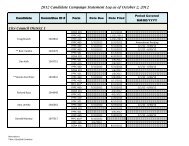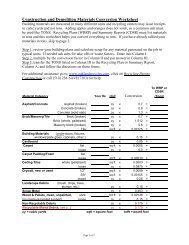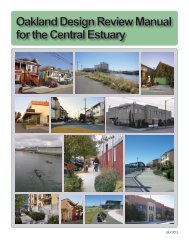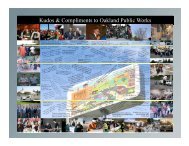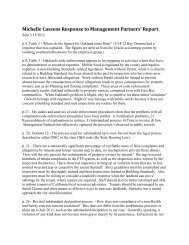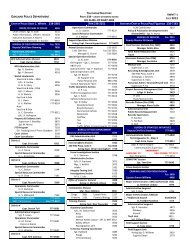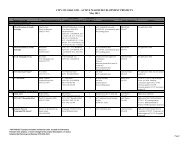Intelligent Transportation Systems - City of Oakland
Intelligent Transportation Systems - City of Oakland
Intelligent Transportation Systems - City of Oakland
You also want an ePaper? Increase the reach of your titles
YUMPU automatically turns print PDFs into web optimized ePapers that Google loves.
note that if an agency does not have an existing Internet connection and one needs<br />
to be added, VPN would not be as cost-effective as leased lines, because the<br />
connection would need to be at both ends.)<br />
• The <strong>Oakland</strong> TMC would be able to interface with all VPN sites with one Internet<br />
connection, rather than paying for and interfacing with the second end <strong>of</strong> all the<br />
leased lines from each agency.<br />
The disadvantage <strong>of</strong> using VPN is that the network is based on open standards that are<br />
still emerging. The market leader today is Micros<strong>of</strong>t, which has implemented a protocol<br />
called PPTP (Point-to-Point Tunneling Protocol). PPTP is a proprietary protocol;<br />
meaning if implemented for the <strong>Oakland</strong> citywide network, only Micros<strong>of</strong>t-compatible<br />
products could be specified. One open standard for VPN, called IPSec (or “IP<br />
Security”), has recently been developed, and products supporting it are now being<br />
shipped. Unlike PPTP, IPSec <strong>of</strong>fers the benefits <strong>of</strong> an open standard that is highly<br />
desirable for most public agencies.<br />
6.5.4 FDN Considerations<br />
Using a conduit and TWP/fiber infrastructure, if readily available, can carry tremendous<br />
amounts <strong>of</strong> data at a fraction <strong>of</strong> the operational cost <strong>of</strong> leased services, even if<br />
maintenance services are contracted on an on-call basis. The cost <strong>of</strong> installing fiber<br />
optics or twisted pairs, if conduit is not readily available, can be prohibitively expensive;<br />
therefore, the communication alternative selection process assumes that fiber or twisted<br />
pair will be used wherever conduit is pre-existing. Where conduit is not pre-existing, an<br />
evaluation needs to be performed to decide whether or not to install new conduit and/or<br />
fiber optics, build a wireless link, or make use <strong>of</strong> leased telecommunication services.<br />
6.6 FIELD DEVICE REQUIREMENTS<br />
The ITS field elements require different bandwidths for communications. Most ITS<br />
elements such as VDS and DMS require lower bandwidth. CCTV cameras are the most<br />
demanding and require high bandwidth. This section presents a discussion on relevant<br />
ITS elements that would be deployed in the <strong>City</strong> <strong>of</strong> <strong>Oakland</strong>.<br />
6.6.1 Low Bandwidth Devices<br />
Low bandwidth devices require lower speed connections and can generally utilize TWP,<br />
or low bandwidth wireless communications such as CDPD or dial up to transit data from<br />
a field cabinet to a hub. Fiber optics can also be used to transmit data to and from low<br />
bandwidth devices, if available, but it is not required. Some <strong>of</strong> the low bandwidth<br />
devices being recommended in this Strategic Plan are traffic signal controllers, VDS,<br />
DMS and TBS.<br />
When using TWP or fiber optics to connect to traffic signals, two twisted wire pairs or<br />
fiber strands are required from the backbone (one to transmit data and one to receive<br />
data). Numerous traffic signal controllers can be connected in a daisy chain or ring<br />
configuration (see Figure 6-1) with the same two twisted wire pairs or fiber strands.<br />
Generally, no more than six or eight controllers are interconnected on same circuit. Two<br />
twisted wire pairs or fibers enter each controller cabinet and two twisted wire pairs or<br />
fibers leave each controller cabinet except for the controller on the end <strong>of</strong> the chain.<br />
<strong>City</strong> <strong>of</strong> <strong>Oakland</strong> ITS Strategic Plan<br />
76 September, 2003




